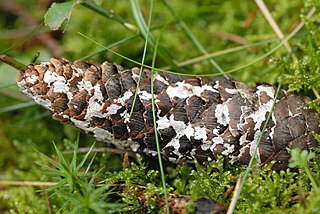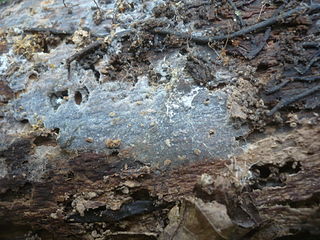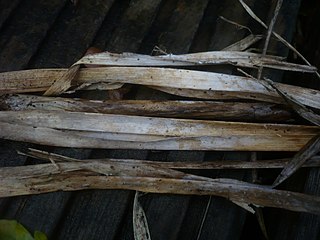
Phanerochaete is a genus of crust fungi in the family Phanerochaetaceae.

Atheliaceae is a family of corticioid fungi placed under the monotypic order Atheliales. Both the order and the family were described by Walter Jülich in 1981. According to a 2008 estimate, the family contains 20 genera and approximately 100 species. However, many genera formerly considered to belong in the Atheliaceae have since been moved to other families, including Amylocorticiaceae, Albatrellaceae, and Hygrophoraceae. Despite being a relatively small group with inconspicuous forms, Atheliaceae members show great diversity in life strategies and are widespread in distribution. Additionally, being a group strictly composed of corticioid fungi, they may also provide insights on the evolution of fruiting body forms in basidiomycetes.

The Meruliaceae are a family of fungi in the order Polyporales. According to a 2008 estimate, the family contains 47 genera and 420 species. As of April 2018, Index Fungorum accepts 645 species in the family.

The Phanerochaetaceae are a family of mostly crust fungi in the order Polyporales.

Byssomerulius is a widely distributed genus of crust fungi.
Candelabrochaete is a genus of crust fungi in the family Phanerochaetaceae.

Scopuloides is a genus of five species of crust fungi in the family Meruliaceae.

Phlebia is a genus of mostly crust fungi in the family Meruliaceae. The genus has a widespread distribution. Phlebia species cause white rot.

Crustoderma is a genus of crust fungi in the family Meruliaceae.

Dendrothele is a genus of fungi in the family Corticiaceae. According to a 2008 estimate, the genus has 36 widely distributed species.

Ceriporia is a widely distributed genus of crust fungi.

Hyphoderma is a genus of crust fungi in the family Meruliaceae. It was circumscribed by German botanist Karl Friedrich Wilhelm Wallroth in 1833.

Hypochnicium is a genus of corticioid fungi in the family Meruliaceae. The genus was circumscribed by mycologist John Eriksson in 1958.

Dentocorticium is a genus of six species of poroid fungi in the family Polyporaceae. The genus was revised in 2018, with several new species added and some older species transferred to other genera, based on phylogenetic analyses.

Epithele is a genus of crust fungi in the family Polyporaceae.

Lopharia is a genus of fungi in the family Polyporaceae. The genus was circumscribed by Károly Kalchbrenner and Peter MacOwan in 1881.

Amaurodon is a genus of fungi in the family Thelephoraceae. Most species in the genus have resupinate and corticioid fruit bodies that grow on rotting wood. The hymenophore may have pores, teeth, or be smooth, and is typically blue to green in color.

Tulasnella is a genus of effused (patch-forming) fungi in the order Cantharellales. Basidiocarps, when visible, are typically smooth, ceraceous (waxy) to subgelatinous, frequently lilaceous to violet-grey, and formed on the underside of fallen branches and logs. They are microscopically distinct in having basidia with grossly swollen sterigmata on which basidiospores are formed. One atypical species, Tulasnella aurantiaca, produces orange to red, gelatinous, pustular anamorphs on wood. Some species form facultative mycorrhizas with orchids and liverworts. Around 80 species of Tulasnella are known worldwide.
Efibula is a genus of 16 species of crust fungi in the family Irpicaceae.
Fibricium is a genus of fungi belonging to the family Repetobasidiaceae.
















